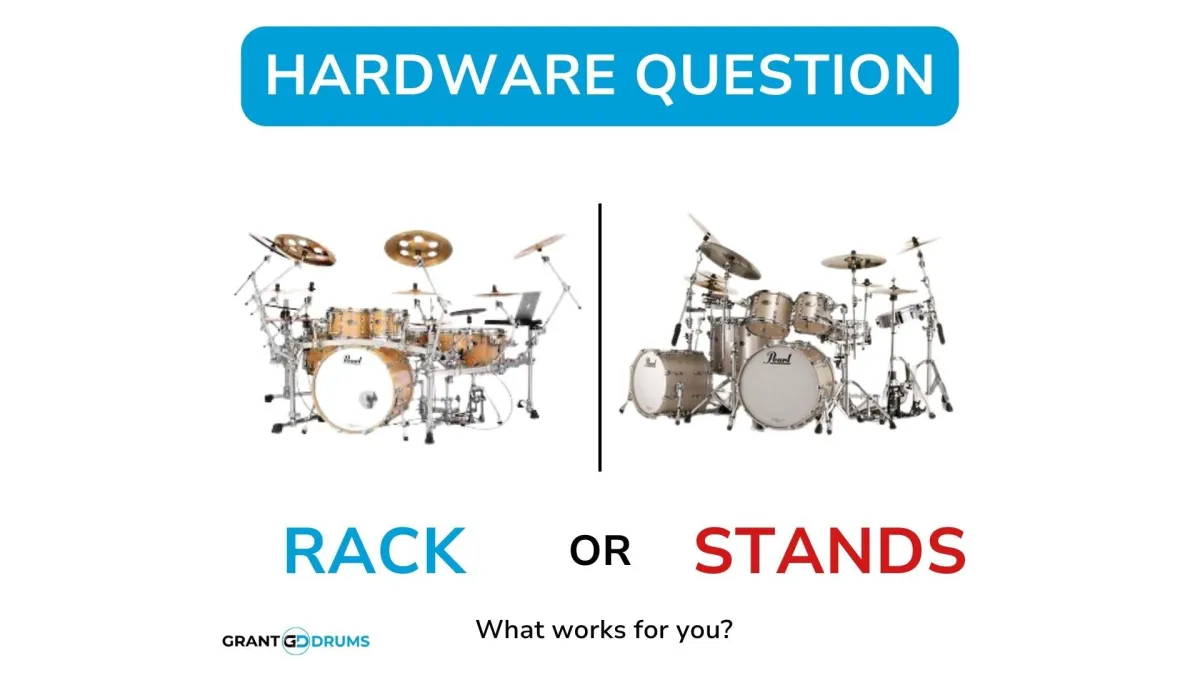ACADEMY MEMBERS
LEARNING TIME
with


Rack It Up or Stand Alone: Choosing Between Drum Racks and Hardware Stands
Drummers, assemble! Today's battle is fought not on the stage, but in the setup zone. We're diving into the age-old debate: drum racks vs. hardware stands. Deciding which system is right for you depends on your drumming style, gigging situation, and budget. So, grab your sticks and let's break down the pros and cons of each approach.
Drum Racks: The All-in-One Arsenal
Drum racks offer a streamlined way to mount and organize your hardware:
Space Saver: Racks consolidate your cymbals and toms onto a single structure, minimizing your footprint on stage or in the practice space.
Customizable Chaos: Racks provide immense flexibility. You can position your cymbals and toms exactly where you want them, creating a truly personalized setup.
Fast Breakdown (Sometimes): Once you get the hang of it, a well-designed rack system can disassemble and assemble quicker than a forest of individual stands.
However, racks come with their own challenges:
Bulk and Weight: Racks themselves can be heavy and cumbersome, especially for smaller drummers or those navigating tight spaces.
Initial Investment: Quality drum racks can be expensive, requiring a significant upfront investment compared to individual stands.
Level Woes: Uneven stages can wreak havoc on a rack's stability. Individual stands might be more forgiving on less-than-perfect surfaces.
Stands Alone: The Classic Choice
The trusty hardware stand remains a popular choice for drummers:
Affordable Option: Individual stands are generally less expensive than a full drum rack, making them a budget-friendly choice for beginners or drummers with a limited kit.
Adaptability: Stands offer some adjustability for cymbal and tom placement. You can swap stands in and out depending on your needs for different gigs.
Simplicity: Stands are easy to set up and break down, requiring no complex assembly or disassembly procedures.
But individual stands also have limitations:
Space Hog: A large kit with numerous stands can sprawl out considerably, eating up valuable stage or practice space.
Limited Customization: While stands offer some adjustability, they might not allow for the same level of precise positioning as a well-designed rack.
Breakdown Blues: Setting up and breaking down a kit with multiple stands can be a time-consuming process, especially for larger setups.
Finding Your Drumming Sweet Spot
The ideal setup depends on your individual needs. Here are some tips to guide your decision:
Consider Your Kit Size: Drummers with extensive setups might benefit more from the space-saving capabilities of a rack.
Think About Gigging: If you play frequent gigs, a rack's faster breakdown time (after initial setup practice) might be a valuable asset.
Budget Matters: If you're on a tight budget, individual stands offer a more affordable entry point.
The Hybrid Hero: Combining Stands and Racks
Don't be afraid to mix and match! Here's why:
Flexibility is Key: You can use a rack for your toms and cymbal arms, while keeping your hi-hat and snare on individual stands for a customized and potentially more affordable setup.
Start Small, Expand Later: As your drumming evolves and your kit expands, you can gradually add rack components to your existing stand setup.
Remember: There's no one-size-fits-all answer. Experiment with both racks and stands to see which system best suits your drumming style and needs. Happy drumming, and may your hardware setup be as efficient as your playing!
Sick of losing focus and trying every drum exercise you can find on YouTube?
It's time for the...


FREE DRUM CHART
CHOP CHOP
Drum Chart
22 Time Signature Changes in 59 Seconds!
Enter your details and get the chart to your inbox in minutes!
You will receive your Free PDF Chart to your inbox. Please check your spam filters if you can't see it.
Your email will come from help@mail.grantdrums.com



